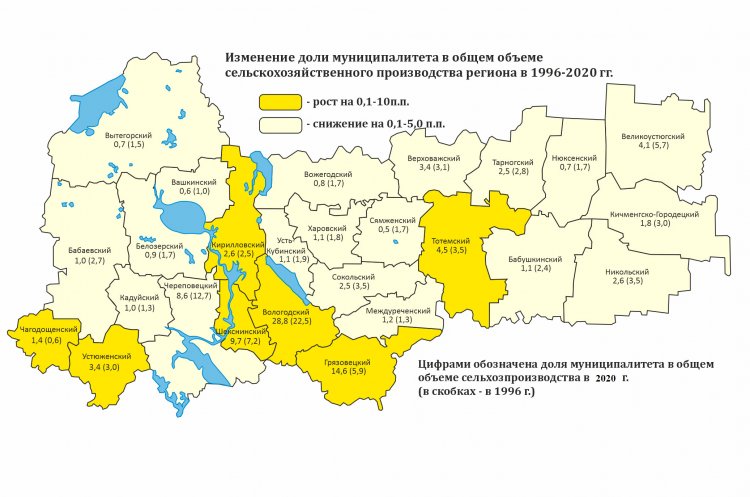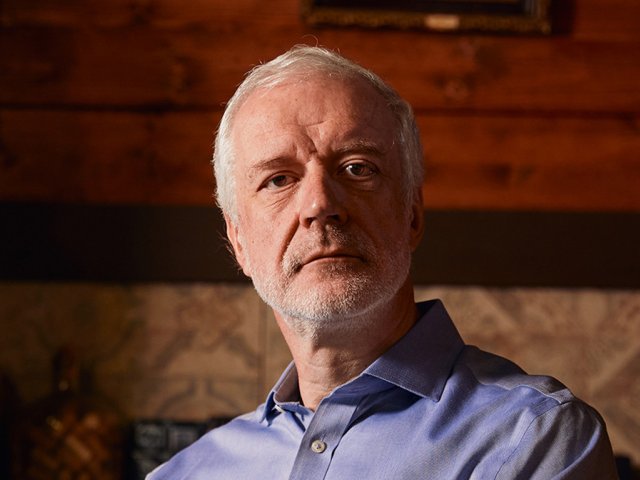Vologda scientists study the problems of ensuring balanced spatial development of the northern regions of Russia in context of solving strategic tasks of the country development
Urge for a comfortable environment, conveniences of modern infrastructure, life in megacities, and greater personal development opportunities are driving the centripetal vector of population migration from rural areas, small, and medium cities, which leads to breaking the existing socio-economic ties between the country’s regions. Over the last few decades, these problems have been particularly acute in the northern regions, which occupy almost 2/3 of the Russian territory. These circumstances actualize the scientific and practical significance of exploring the issues related to creating an environment favorable for the modern person's life and conducting economic activities in all corners of our country, as well as the issues related to reducing the excessive differentiation among the regions by key socio-economic development parameters.
According to the experts, these problems can be solved through utilizing each territory’s competitive advantages and potential to solve the tasks of Russia's strategic development. At the same time, in this case, the potential of socio-economic systems should be considered more broadly, including not only natural resources and production, but also the potential related to human resources, geostrategic considerations, transportation, logistics, etc. Within this approach, it is extremely important to count the vast socio-economic (and not only natural) space of Russia's northern and Arctic territories among the strategic resources for national development.
Currently, scientists of the Vologda Research Center of the Russian Academy of Sciences (city of Vologda) are implementing comprehensive research on the spatial and territorial development of the Russian European North. The experts propose effective tools for developing not only large cities and emerging urban agglomerations in the North, but also medium/small cities and rural areas – the most important element of the regional space. They focus on such issues as ensuring the ecological and economic balance of the northern territories, as well as developing their transportation and logistics system. According to the researchers from Vologda, restoring interregional ties along the North – South line and revising federal and regional policy accents will ensure sustainable development of the northern territories’ socio-economic systems.
Sergey Aleksandrovich Kozhevnikov – Candidate of Economic Sciences, Deputy Head of the Department, Leading Researcher of the Laboratory of Spatial Development and Placement of Production Facilities of the Vologda Research Center of the Russian Academy of Sciences (VolRC RAS) (city of Vologda) – spoke about the currently implemented socio-economic development strategies of the constituents of the Russian European North and the key areas and tools for improving the management of their spatial development.
“Overall, spatial issues are among the key areas of research conducted by the VolRC RAS, dating back to the mid-90s. Studies of that period focused on the spatial development specifics of industries and production complexes of the region's economy (forestry, agriculture). The development of territorial clusters and urban agglomerations, and Vologda in particular, was also emphasized.
Later, this area was consistently expanded and deepened, the methodology and object of the research developed. A number of state-commissioned scientific projects and projects within the program of the Presidium of the RAS were implemented. They were devoted to establishing and developing growth points of the northern and Arctic regions, as well as studying the rural areas and their spatial transformation in the post-Soviet period. Later, the research center implemented a number of research projects, which considered the European North as a springboard for the development of the Arctic region. As part of these projects, we collaborated with colleagues from the Institute of Geography of RAS (city of Moscow, Cand. Geo. Sc. O. B. Glezer), the Institute of Socio-Economic and Energy Problems of the Komi North of the Research Center of the Ural Branch of the Russian Academy of Sciences (city of Syktyvkar, Corresponding Member of the Russian Academy of Sciences, D. Geo. Sc. V. N. Lazhentsev), and others.
This year we have been actively working on new grant projects dedicated to the spatial development of the Russian European North. The center also performed a number of contractual works on behalf of the Vologda City Administration and the Vologda Municipal District Administration to design model strategies for the socio-economic development of rural settlements and development of inter-municipal cooperation, including within the Vologda agglomeration,” said Sergey Kozhevnikov, outlining the ways of formation and development of the research interest in studying spatial development of the Russian European North.
Why is this problem relevant in scientific and applied terms?
“In recent decades, the topic of spatial development has been on the forefront of the world science. It is no coincidence that in 2008, P. Krugman was awarded the Nobel Prize in Economics for his contribution to the development of the new economic geography theory and research in the field of international trade, which proved the influence of agglomeration processes on improving the efficiency of economic activity at certain spatial points.
The practical significance of spatial issues is also high. Thus, in 2019, the Spatial Development Strategy of Russia until 2025 and its implementation plan were adopted at the federal level. These documents have consolidated the general principles and directions of the country's spatial development. At the same time, the scientific and expert community has repeatedly noted the “bottlenecks” of these documents and the need for a certain revision of the state policy priorities in this area. The VolRC RAS prepared expert opinions on these documents and sent them to the relevant federal bodies,” the researcher clarified.
In the modern research community, there are different theoretical and methodological approaches to understanding the essence of the economic space and its development factors. Vologda scientists, as Sergey Kozhevnikov noted, “rely on the classical Russian school – both the Soviet one (I. G. Alexandrov, N. N. Nekrasov, N. N. Baransky, etc.), and of the modern Russian era (P. A. Minakir, V. N. Lazhentsev, A. I. Tatarkin, A. N. Pilyasov, etc.). At the same time, we also follow the foreign science (the new theory of trade, the new economic geography, “smart” city theories, etc.). We try to critically examine them and conduct an interdisciplinary synthesis of traditional methodological approaches established back in the Soviet school and new trends of the world spatial science. When performing spatial research, personally I am guided by the methodological approaches developed within the Far Eastern School under the guidance of Academician of RAS P.A. Minakir and researchers from the Komi National Research Center of RAS (lead by Corresponding Member of RAS V.N. Lazhentsev).”
As the scientist from Vologda notes, “Russia is the largest country in the world in terms of territory, and so the question arises: is the space our curse or resource? Thinking about Russia this way, many foreign colleagues tend to the former approach, believing that the enormous territory decelerates the development of our country. In our own research, we try to prove that space is undoubtedly a resource: the source of our country's economic growth lies in the diversity of conditions and potential of various territories. This is especially true of the North and the Arctic. And we cannot but recall M. V. Lomonosov's prophetic words: “Russian power will grow by Siberia and the Northern Ocean.” And if in the early 1990s, Russia actually started to “withdraw” from the Arctic and the North, the country’s highest authorities firmly believe in the geostrategic nature of these territories. All our research is carried out within this ideological approach.”
For the last four years, young researchers (N. V. Voroshilov, S. S. Patrakova, I. A. Sekushina, M. A. Lebedeva, N. A. Lebedeva) have been working on this topic in the VolRC RAS Laboratory of Spatial Development and Placement of Production Facilities, which is headed by Sergey Kozhevnikov. At the moment, Kozhevnikov supervises works carried out in several areas, both commissioned by the state and paid with grants from scientific foundations. In 2021, Sergey Alexandrovich led three such grant projects: Russian Presidential Grant MK-2099.2020.6. “Mechanisms of managing the spatial integration of the economy of the regions of the Russian European North in context of implementing the Spatial Development Strategy of the Russian Federation for the period until 2025”; RSCI Grant No. 20-110-50192 “Spatial integration of the economy: theoretical concepts and problems of provision at the regional level”; RSCI Grant No. 19-410-350010 “Regional policy of the Russian Federation constituents for the development of municipalities: evaluation and efficiency improvement directions.”
What directions of improving the spatial development management of the Russian European North are proposed today?
“We can see that since the 1990s, when we moved to the market and foreign trade was liberalized, many northern regions started to focus more on the trade integration with foreign countries as exporters of mineral raw materials and low-value goods. Let's take Siberia and the Far East – China is their key trading partner; for Karelia it is Finland, etc.
This was to the detriment of the development of interregional ties inside the country. It led to the increasing crisis in the domestic manufacturing industry, “washing out” of entire industries and, as a result, destruction of the economic base of the development in a plethora of localities (villages, small and medium cities).
Thus, if by the beginning of the reform period, agricultural production in the Vologda Region was fairly evenly distributed across the territory and provided local consumers with its products, while now it is concentrated near the largest cities, and the industry on the periphery has been ruined (see Fig. 1). This has exacerbated the problem of local unemployment, low revenue for local budgets, etc.
Fig.1. Dynamics of the share of municipalities in the total volume of agricultural production of the Vologda Region in 1996-2020, pp.
In this regard, one question naturally arises: how to use and develop the potential of the northern territories not only in terms of exporting raw materials, but as a base for the domestic economy modernization through integrating them to national value chains. Again, it is important to pay attention not only to agglomerations, but also to other settlements, to ensure the restoration of intraregional cooperative ties along the “large city – medium/small city – village” line on the new technological basis. Our research is aimed at finding answers to these questions,” the researcher said.
What is the essence of the concept of the Russian European North territories supporting frame?
“Its essence is as follows: the spatial frame of the regions consists of a network of nodal (large cities) and non-nodal elements (rural areas) connected by infrastructure. Previously, the North had a fairly distributed network of large, medium, and small cities.
However, the crisis in the economy of northern single-industry cities and villages led to active migration of the population to the more southern territories of the country. Thus, the Russian European North lost almost 1.6 million people in 30 years. As a result, the spatial framework of the country's northern regions was significantly deformed due to the reduced role of small and medium-sized cities in the general settlement system. This is confirmed by our calculations of the country's settlement system based on Zipf's law.
As follows from Figure 2, the population of most small and medium-sized cities in the North (and other regions of the country) significantly deviates from the ideal straight line, i.e., the real population of these settlements is below the ideal population for our country.
Figure 2. Distribution of Russian cities with a population of more than 30 thousand people (2019, 502 cities; adjusted values).
This is explained by both the natural decline of their population and the residents' migration to million-plus cities. Our research has revealed the key reasons explaining why people leave for big cities: no jobs, no self-actualization opportunities, settlement has no prospects. Implementation of the policy aimed at modernizing the economy of these territories, which takes their existing potential into account, can stop these negative processes. Russia should obtain new effective management tools for both large cities and other settlement types. Rural areas are currently supported at the federal and regional levels, but this support is selective. Real investment projects for modernization are required. Maybe the municipality alone does not have the resources to implement the projects, so it has to cooperate with neighboring districts or regions,” Sergey Kozhevnikov said.
What justifies the important role of the Vologda Region as an outpost of Arctic development? What is its geostrategic and natural resource potential?
“The Vologda Region has historically been closely connected with the more northern regions of the country. Back in Soviet times, the large metallurgical plant Severstal and the fertilizer production enterprise Fosagro were built here. They are among the key industrial centers of the Northern Economic Region, which utilize raw materials of the North. Currently, Vologda is a major transportation hub. Northward railways, inland waterways, transport links with Moscow and St. Petersburg are passing through this city. The region has the potential for supplying food to the northern and Arctic territories, as well as the scientific and industrial potential to manufacture products intended for using in the North and in the Arctic (housing construction, mechanical engineering, etc.),” the scientist replied.
What did you reveal by your analysis of the socio-economic development strategies of the European North entities?
“The analysis of strategies and programs of socio-economic development of the Russian European North entities until 2025-2030 allows us to conclude that the priorities stipulated there and the instrumental support for their implementation merely preserves the raw material model of their economy. The mechanisms of real modernization of their economy and integration of the regions into the national value chains are poorly defined.
At the same time, it becomes obvious that it is now necessary to reconsider the management approaches, to look for new growth sources and spatial organization forms of the northern regions' economy. We can see how in Norway, Sweden, Finland, and the USA, small and medium raw material cities with decreasing production of the key industry have transformed and become centers of science, modern technologies, international tourism, organic agriculture, etc. Our task is to find new growth points for small and medium cities that will diversify their economy, accumulate the resources, and ensure their sustainable development in the medium and long term. Each constituent of the Russian Federation may have its own tools, including those based on the concept of designing a “smart” specialization. In order to design a new specialization of a region or a specific city, it is necessary to take into account not only the natural resources and workforce potential of the territories, but also the potential of human resources and innovation (presence of developed scientific schools, researchers, innovative enterprises), which will create new innovative industries and businesses. But it is almost impossible to accomplish all of that alone. We need real interregional cooperation,” Sergey Kozhevnikov summed up.
Thus, the research of the VolRC RAS scientists shows that balanced spatial development of the northern regions depends on designing a unified concept of their development focused on modernizing the economy of small and medium cities, searching for mechanisms to integrate the space along the “city – village” route, as well as developing sustainable cooperative, social, and infrastructural ties both with each other and with southern areas of the country.
All images are provided by Sergey Kozhevnikov























